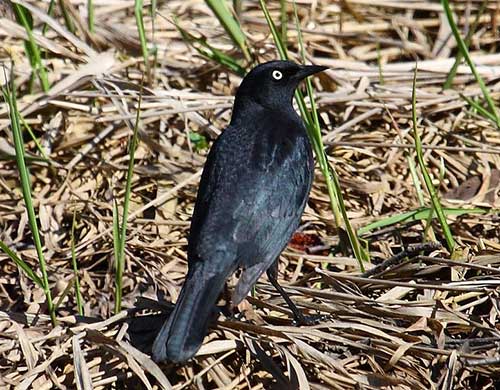
Alaskans Can Help Answer “Where Have All the Rusty Blackbirds Gone?”
2015 Rusty Blackbird Spring Migration Blitz Runs April 11–May 31
April 11, 2015
Saturday PM
(SitNews) - From April 11 through May 31, Alaskans can use their binoculars to help birds—by reporting sightings of Rusty Blackbirds for the Rusty Blackbird Spring Migration Blitz. This is the second year of the three-year project. Researchers across North America are teaming up with citizen scientists to help solve the mysterious decline of the Rusty Blackbird. Audubon Alaska is coordinating the Alaskan effort this year.
“Whether you’re an experienced birder or just beginning, citizen science projects like the Rusty Blackbird Blitz are a great way to help answer important questions about the birds that flood back to Alaska each spring,” said Beth Peluso of Audubon Alaska. “Since you can report your sightings in the online database called eBird, anyone can participate from anywhere in the state. Starting observations this early in migration season in Alaska will help document first arrivals of Rusty Blackbirds within the state.”

In March , male Rusty Blackbirds retain some of their rusty-tipped feather edges. By May (above), males appear glossy black.
Identification guide at RustyBlackBird.org
photograph courtesy Wikipedia Commons www.wikipedia.org
The Rusty Blackbird has suffered one of the steepest declines of any bird in North America, 88–98% since 1966. Although the decline of this once common and abundant bird slipped beneath the radar for researchers until recently, there is historical evidence it has been going on for a century or more. The Rusty Blackbird is now included in the IUCN’s Red List of Threatened Species, the U.S. Fish and Wildlife Service’s Birds of Conservation Concern, and the Audubon Alaska WatchList of declining and vulnerable birds.
“In 2014 we had great participation from Alaskans,” said Peluso. There were 314 checklists, which counted 689 Rusty Blackbirds, submitted from the state. There were counts from two national Wildlife Refuges, Tetlin and Kanuti, and from 20 communities, from Juneau to the North Slope. “We’re hoping even more Alaskans grab their binoculars and head out to count Rusties this spring," said Peluso. “The birds are spreading out onto their nesting territories when they reach Alaska, so most of the observations last year were of small groups of Rusty Blackbirds, not more than ten birds. That means we need lots of eyes out there.”
In spring, you can hear this songbird’s “rusty hinge” song in boreal wetlands in Alaska and Canada. Rusty Blackbirds winter in the southcentral and southeastern United States. Despite the mounting concern for the species, very little was known about its life history or ecology. In 2005, the International Rusty Blackbird Working Group (IRBWG) formed to develop research efforts toward understanding the species and its mysterious decline. The group is composed of researchers from federal, state, and provincial agencies, universities, and NGOs throughout the US and Canada.
Within the last 15 years, scientists have made great strides in understanding the bird’s breeding and wintering ecology, some of the threats it faces, and some of the possible causes for its drastic decline. Habitat loss and degradation on the breeding and winter range, climate change, and contaminant exposure are some of the hypotheses for the dropping numbers, but as yet there is no definite “smoking gun.”
While scientists are beginning to understand something of the breeding and wintering ecology of the Rusty Blackbird, very little is known about its migration. Migration routes, timing, and habitat use during migration remain almost completely unknown. Are there regular migration routes or hot spots where many individuals congregate? Are there migration stopover areas that are used predictably each year, and if so, are these locations protected? What is the range of potential threats the species faces during migration that could be contributing to its decline?
To answer these questions, the International Rusty Blackbird Working Group (IRBWG) created The Rusty Blackbird Spring Migration Blitz. The three-year Migration Blitz is a continental effort in which citizen scientists document the timing and location of the species’ migration routes from wintering grounds to the boreal wetlands in Alaska and Canada. Each participating state, province, and territory has a 3-8 week target window during which birders will search for Rusty Blackbirds and report their findings. This vital research - conducted with the participation of thousands of volunteer observers - will help answer important basic questions of migratory behavior and will focus future research and conservation efforts for one of North America’s most vulnerable songbirds.
On the Web:
Audubon Alaska WatchList of declining and vulnerable birds.
http://ak.audubon.org/sites/default/files/
documents/ak-watchlist-2010.pdf
International Rusty Blackbird Working Group (IRBWG)
http://rustyblackbird.org
For more information:
Edited by Mary Kauffman, SitNews
Source of News:
Audubon Alaska
http://ak.audubon.org
Publish A Letter in SitNews
Contact the Editor
SitNews ©2015
Stories In The News
Ketchikan, Alaska
|
Articles &
photographs that appear in SitNews may be protected by copyright
and may not be reprinted without written permission from and
payment of any required fees to the proper sources.
E-mail your news &
photos to editor@sitnews.us
Photographers choosing to submit photographs for publication to SitNews are in doing so granting their permission for publication and for archiving. SitNews does not sell photographs. All requests for purchasing a photograph will be emailed to the photographer.
|
|

